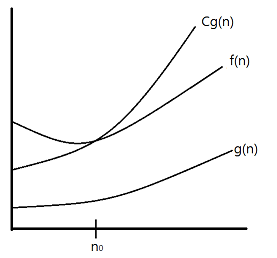Introduction
Big-O notation is used to estimate time or space complexities of algorithms according to their input size. Big-O notation usually only provides an upper bound on the growth rate of the function, so people can expect the guaranteed performance in the worst case. Due to the reason, Big-O is more widely used by developers compared to Big-Theta and Big-Omega.
Definition
 Let \(f\) and \(g\) be two functions defined on some subset of the real numbers.
If there is a positive constant \(C\) such that for all sufficiently large values of \(n\), the absolute value of \(f(n)\) is at most \(C\) multiplied by the absolute value of \(g(n)\). That is, \(f(n) = O(g(n))\) if and only if there exists a positive real number \(C\) and a real number \(n_0\) such that
Let \(f\) and \(g\) be two functions defined on some subset of the real numbers.
If there is a positive constant \(C\) such that for all sufficiently large values of \(n\), the absolute value of \(f(n)\) is at most \(C\) multiplied by the absolute value of \(g(n)\). That is, \(f(n) = O(g(n))\) if and only if there exists a positive real number \(C\) and a real number \(n_0\) such that
\(|f(n)| \le C|g(n)|\)
for all
\(n \ge n_0.\)
Let’s see examples for better understanding. There are two algorithms written in C for sum from 1 to n. (The comment of each line means the operation number.)
// Algorithm1
int calcSum(int n) {
int i = 1; // 1
int sum = 0; // 1
for(; i<=n; ++i)
{
sum = sum+i;
} // 3n+1
return sum;
}
// Total operation number: 1+1+3n+1 = 3n+3
// Algorithm2
int calcSum(int n) {
int count = n; // 1
int sum = 1+n; // 1
sum = sum*count; // 1
sum = sum/2; // 1
return sum;
}
// Total operation number: 1+1+1+1 = 4
Big-O notation for Algorithm1
There exists \(C\) and \(n_0\) such that
\(|3n+3| \le C|n|\)
for all
\(n \ge n_0.\) (e.g. \(C=4, n_0=3\))
Therefore, \(3n+3 = O(n).\)
Big-O notation for Algorithm2
There exists \(C\) such that
\(|4| \le C|1|.\) (e.g. \(C=4\))
That means, \(4 = O(1).\)
Polynomial Expression
In real situations, we may face more complicated expressions than the examples above. Let’s suppose that the complexity function \(f(n)\) is \(n^2+2n+1\), and we need to simplify this expression using Big-O notation. To say the conclusion first, among the three terms \(n^2\), \(2n\), and \(1\), the one with the highest growth rate will be used as follows: \(O(n^2)\).
Theorem
\(f(n)=O(n^k)\), where \(f(n)=a_nn^k+a_{n-1}n^{k-1}+...+a_1n+a_0\) and \(a_0,a_1,a_2,...,a_{n-1},a_n\) are real numbers.
Proof:
For all \(n \ge 1\),
\(|f(n)|=|a_nn^k+a_{n-1}n^{k-1}+...+a_1n+a_0|\)
\(= |a_n|n^k+|a_{n-1}|n^{k-1}+...+|a_1|n+|a_0|\)
\(= n^k(|a_n|+|a_{n-1}|/n+...+|a_1|/n^{k-1}+|a_0|/n^k)\)
\(\le n^k(|a_n|+|a_{n-1}|+...+|a_1|+|a_0|)\)
Therefore, \(|f(n)| \le Cn^k\) where \(C=|a_n|+|a_{n-1}|+...+|a_1|+|a_0|\) and \(n_0=1.\) Consequently, \(f(n)=O(n^k)\)
Going back to \(f(n)=n^2+2n+1\), we can use the same approach in order to make Big-O notation for \(f(n)=n^2+2n+1\).
For all \(n \ge 1,\) (\(n_0=1\))
\(|f(n)|=n^2+2n+1\)
\(=n^2(1+2n^{-1}+n^{-2})\)
\(\le n^2(1+2+1) = 4n^2\)
That is, \(f(n)=O(n^2)\) (\(C=4\), \(n_0=1\))
Other Useful Theorems
Many algorithms consist of two or more sub-procedures. We can derive their proper Big-O notations using the sub-procedure’s Big-O.
Theorem 1
Let \(f_1(n)=O(g_1(n))\) and \(f_2(n)=O(g_2(n))\).
Then, \((f_1+f_2)(n)=O(max(|g_1(n)|,|g_2(n)|))\).
Proof:
By the definition of Big-O, there exists \(C_1,C_2,k_1,k_2\)
such that \(|f_1(n)| \le C_1|g_1(n)|\) for all \(n>k_1\) and \(|f_2(n)| \le C_2|g_2(n)|\) for all \(n>k_2\).
Also, let \(n \ge max(k_1,k_2)\), \(g(n)=max(|g_1(n)|,|g_2(n)|)\), and \(C=C_1+C_2\).
\(|f_1(n)+f_2(n)|\)
\(\le C_1|g_1(n)|+C_2|g_2(n)|\)
\(\le C_1|g(n)|+C_2|g(n)|\)
\(= (C_1+C_2)|g(n)|\)
\(= C|g(n)|\)
Corollary:
\((f_1+f_2)(n)=O(g(n))\), where \(f_1(n)=O(g(n))\) and \(f_2(n)=O(g(n))\).
Theorem 2
Let \(f_1(n)=O(g_1(n))\) and \(f_2(n)=O(g_2(n))\).
Then, \((f_1 f_2)(n)=O(g_1(n)g_2(n))\).
Proof:
Let \(n \ge max(k_1,k_2)\) and \(C=C_1C_2\)
\(|(f_1 f_2)(n)|=|f_1(n)||f_2(n)|\)
\(\le C_1|g_1(n)|C2|g_2(n)|\)
\(\le C_1C_2|(g_1g_2)(n)|\)
\(\le C|g_1g_2|(n)\)
References
- Big O notation, Wikipedia, https://en.wikipedia.org/wiki/Big_O_notation
- Discrete Mathematics and its Applications 5th edition, Kenneth H. Rosen, McGraw-Hill Education
- Data Structures for Game Programmers, Ron Penton, PremierPress
- Big-O Notation, openparadigm’s blog, http://openparadigm.tistory.com/20